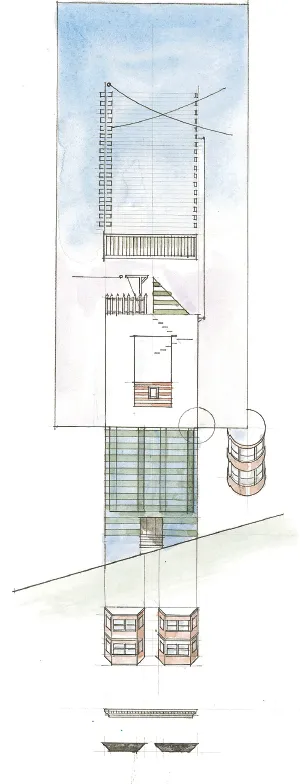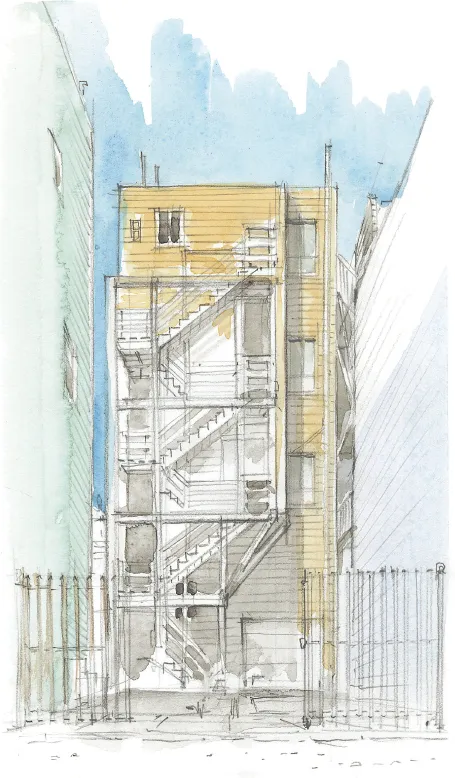![]()
Arriving | Arriving in San Francisco from the north across the Golden Gate Bridge, the first Indians.
From the south, along the coast or the bay, on the freeways, the missionaries and the campesinos from Latin America.
From the east, across the Bay Bridge, the whites from Europe and America.
From the west, by sea or by air, from China and Japan.
Toponymy | There are no pelicans on Alcatraz, no angels on Angel Island, no treasures on Treasure Island, no oysters in Oyster Bay, no beaches at North Beach, no good grasses on Yerba Buena Island.
I Don’t Live There Anymore | Thinking about San Francisco and writing the first words that come to mind: wind, light, bay, skyscrapers, bridge, Berkeley, Noe Valley, North Beach, rails, streetcar, bus, waiting for the bus at Mission Street, driving the freeways, exit, Washington Park, green lawns, sloping lawns, Dolores Park, Alcatraz, ships passing slowly by, ship horns in the night, fine drizzly rain, fog straddling the mountains, the cool breeze looking toward Angel Island, the bridge that looks like a necklace, the bridge that lights up at night, looking fearfully at the ocean, paying the toll, entering Lombard Street, climbing the hills, pressing on the gas pedal going uphill, entering South of Market, the lofts and warehouses, then downtown, the tops of the high-rises, thinking about the American city, the city where, at the end of the road, there is always a big bridge, roller coasters, Chinese gates, gleaming white marble department stores, going in one and wanting to come right out, finding myself in a square, hedges and jugglers, going into the parking lot, paying, coming out of the parking lot, crossing Chinatown, entering North Beach, the red wood of the Caffe Trieste, Columbus Avenue, the white spires of the church, Stockton Street, looking for my house, looking up, the door is closed, I don’t know the names on the doorbells, I don’t live there anymore; I haven’t lived there for more than twenty years.
The House in North Beach | The house on Stockton Street, in North Beach, was a three-story building with six apartments, two on each floor. Like all the others on the street, the house had two faces: the façade on the street decorated and embellished; the one in back simple, stripped-down and functional, but maybe more beautiful.
From the street the house looked like a female body: the two breasts were the rounded bow windows; the eyes, the double-hung windows; the eyelids, the roller blinds behind the glass; the eyelashes, the slightly affected Victorian dentil molding of the cornice under the eaves.
In back, it was a different house. Nothing was done for effect: just horizontal wooden boards, simply painted white. The outside stairs, also wooden, were intimate and safe, and the clotheslines stretched away from the windows to reach self-standing poles with pegs, totem sculptures, slender ladders to the sky.
But to discover the most sublime aspect of the house, you had only to climb the outside stairs up to the terrace: a wooden deck surrounded by a railing and resting on the roof. Here the universe opened up: the city spread out all around like a kasbah. The pink, white, and blue houses were a child’s toy blocks. The bay stretched blue-green, dotted with sails and plowed by ships. Farther away, the islands, the promontories, the Golden Gate, and then the ocean.
The deck of the North Beach house was the bridge of a ship, the rooftop terrace of a palace in Zanzibar, a paradise room floating in midair.
Profile | A city by the sea whose whiteness shines brightest in the afternoon light. Then it turns golden when its highest, most massive building, fluted like a diamond, reflects the light of the setting sun. Then silvery, like the sky at dusk, which over the ocean is an intense red like the horizon in a Japanese print. When night falls, the city lights up with millions of lanterns, and downtown is transformed into a luminous ocean liner.
Houseboats | Houseboats, like the little ones floating in the shallow water of the bay at Sausalito; tidy and orderly as the houses in a subdivision, they are anarchic in their individual look. Well-established by now, they are nothing like the primitive houseboats of the hippies. Now they are equipped with all the comforts, cable TV and satellite dishes.
Beyond the bay can be seen the biggest houseboat of all, the city-boat of San Francisco: dozens of buildings, warehouses, piers, wooden houses lined up along uphill streets. When the tops of its high-rises barely stick up out of the fog enveloping them, the whole city seems to float on the waters of the bay.
Fog | How many kinds of fog are there in San Francisco? The rarefied, almost transparent fog that lets the blue of the sky through. Or the fog that, like a big blanket, settles over the islands and hills, turning them into secret white tumuli. There is the fog that, once it has sifted through the big bridge, unravels across the bay to graze against Alcatraz and Angel Island, still in the sun. And there is the intense, cold fog that wraps around us on the quiet streets of the Sunset or the Richmond, toward Ocean Beach. There, even daytime is a damp, gray night.
There are other fogs, dozens of other kinds, depending on the neighborhood, the time of day, the position of the sun: fog sliced by swords of light, fog that unrolls in vaporous puffs, fog that bleaches the colors of the ships on the bay or envelops the antennas of Twin Peaks like a bush enwraps a cactus in the desert.
San Francisco, city of fog: a fog of many faces, changeable, capricious, imposing.
Seagulls | I watch the seagulls flying over the bay. Some will alight next to the tables at Sam’s Anchor Cafe in Tiburon, hoping to grab a tidbit or two of boiled crab. Others zoom past, just grazing the water on their way to join their buddies at Alcatraz, and still others fly high toward the mounts of Presidio or Twin Peaks. There are also the ones that stand still, solitary, contemplating the world from a pole stuck in the water, or flutter about with other gulls in the wake of a ship headed toward Oakland.
Like pigeons in a city square, the gulls make the bay their own: a vast open space, rich with food, games, opportunities.
The Grid | Looking at a map of San Francisco, one notices that the city is divided into three main zones, corresponding to three different street patterns. The dominant one is a squared grid running north-south, which takes in all the central part of the city, adjacent to the bay and to Ocean Beach. This precise geometry is interrupted only by the irregular Presidio grounds and the sinuous roads running inside Golden Gate Park.
The second pattern results from the disruption of this grid by the diagonal cut of Market Street. The whole area South of Market consists of a 45-degree turn of this same grid. This shift remains in place all the way to South Van Ness, where the streets swivel once again to resume the north-south orientation of the city.
The third pattern is found around the heights of Twin Peaks. There the streets completely abandon the rules of the grid, their paths resembling a tangle of coiled hair.
Overlaid on these street patterns, but totally independent of them, are the freeways that, flouting all rules, stretch across the city like snakes slithering along the ground.
Dolores Street | Once I made drawings of San Francisco’s streets, not from life, but as I remembered them. One of them was Dolores Street. It was a vertical drawing. In the lower part of the paper I outlined the precise profile of Latin America. Using watercolors I flooded it with green, as though the entire continent were one big tropical forest. Toward the top, after the Isthmus of Panama, the continent widened in the shape of Mexico, then mutated, with a highly imaginative leap of scale, into the layout of the San Francisco peninsula. There, the green mass became, in a rapid metamorphosis, a row of equally green tropical palm trees lined up in the middle of Dolores Street. The street then went on, in perspective, to flow into Market Street.
Dolores Street is the last segment of a path that over time has brought the people of Latin America to San Francisco. It is the symbol of this path and of its point of arrival: the point where the Mission District and the palm trees of Dolores Street merge with the American downtown.
Waters | Treacherous, cold, tormented are the waters of the ocean.
Energetic, cool, and ruffled the waters flowing through the Golden Gate.
Gray, still, marshy the waters of the rest of the bay.
The Interrupted Grid | The street grid made up of straight lines and right angles covers the entire city—sometimes it is oriented in a north-south direction, following the original grid of Yerba Buena, the little plot of urbanized ground that became San Francisco; other times it is on a slant relative to the older grid.
The plan to spread the grid like a blanket over the entire territory was not unopposed. Many, seeing the grid as a gift to real estate speculators whose purposes were suited by such an elementary form of urban planning, would have preferred a model more in keeping with the hilly configuration of the entire peninsula. Despite these criticisms, despite the attempts of architects in the City Beautiful movement to temper the cold geometry of the grid with a system of radiating boulevards, despite the few isolated examples of naturalistic landscaping carried out on the summits of some hills such as Telegraph Hill, the grid won the battle. Even now it reigns unchallenged, fighting only its own topographical incongruence, the city’s steep climbs, its dangerous descents.
But the streets, s...






